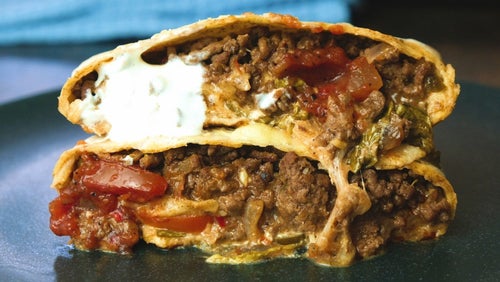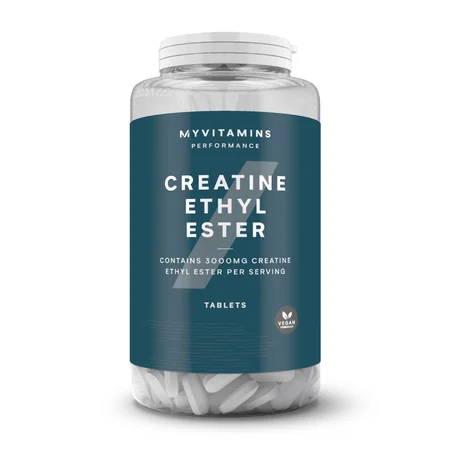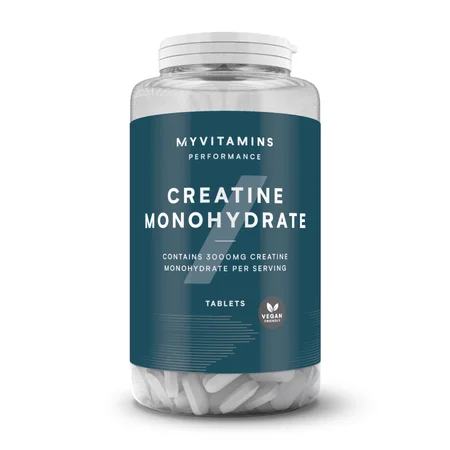How To Take Creatine | Best Uses For Your Fitness Goals

Creatine is one of the most studied supplements and one of the best you can buy when looking to increase muscle mass, strength and power.
There are a number of different types of creatine and different methods in which to supplement it but the biggest decision you have to make when supplementing it is whether to follow a loading phase or maintenance.
- How to take creatine for a loading phase.
- How to take creatine for a maintenance phase.
- Which creatine should I take?
- What is the best way to take creatine?
- Creatine intake comparison table.
What is Creatine?
Creatine is a naturally occurring molecule found in food sources such as meat, poultry, fish and shellfish. It is formed in the body from the amino acids arginine, glycine and methionine. The majority of the body’s creatine is stored in muscle cells as phosphocreatine (PCr).1 Phosphocreatine helps the body produce energy during high intensity exercise such as sprinting and weight lifting.1
Forms of creatine
Creatine monohydrate is the most extensively studied form of creatine and results showing increased gains in muscle mass, strength and exercise capacity. Studies extensively show that creatine monohydrate is the optimal form for increasing creatine storage and there is no scientific evidence to show other forms are superior.2 Creatine monohydrate is available in powder, capsule or gummy form.
Creapure is the purest of form of creatine monohydrate available on the market. It is rigorously tested to ensure it is free from impurities and contains 99.99% creatine content. Creapure is alos available in powder, capsule or gummy form.
Food sources high in creatine
Creatine is naturally found in food sources such as meat, poultry, fish and shellfish. Herring has one of the highest amounts of creatine with 6-10g/kg. Pork (5g/kg), beef (4.5g/kg), salmon (4.5g/kg) and tuna (4g/kg) are other food sources with the highest creatine content.3
How to take creatine to improve athletic performance
The best way to use creatine to improve athletic performance is to train with maximal creatine storage. Therefore, in order to boost athletic performance, following a loading strategy at the start of training program and continuing with a maintenance dose throughout will most likely provide the best results.
How to take creatine for a loading phase
Creatine loading is where you take a high dose to maximise your creatine storage as early as possible. This will allow you start making the benefits in the gym earlier – leading to increased long-term progression and improved performance.
A typical strategy for creatine loading would be to take 20g (4x5g) for 5-7 days.1 This will make sure your creatine stores are maximised and you are able to start getting in the extra reps and sets during gym sessions.
Whilst loading will allow you to start making gains earlier, the multiple doses throughout the day can make it less convenient than a maintenance phase.
How to take creatine for a maintenance phase
Increasing creatine storage via a maintenance phase may be more convenient as you only have to take creatine once or twice a day. It may also to help to reduce the reported side effects that a loading phase may cause. These include increased water retention and stomach cramps.2
A maintenance phase will take longer to saturate your creatine storage so it will take longer to start to see a benefit during your training or performance.
A typical maintenance dose would 3-6g a day. Supplementing this way will maximise your creatine in approximately 28 days.1

Which creatine should I take?
One of the most studied forms of creatine is creatine monohydrate and the evidence suggests that are no forms more effective at increasing creatine storage.3 An example of creatine monohydrate is Creapure, which has a 99.99% purity of creatine monohydrate.
Creatine comes in a powder form or capsule form. Whilst there is not much difference in how effective each form is increasing creatine storage; a powder form may be more convenient if you enjoy shakes and smoothies whilst capsules don’t need to mixed with anything so they might make a better option for when you’re on the go.
Kre-alkyln creatine is creatine with added alkaline powder (e.g., bicarbonate) that changes the pH of the powder. It is claimed that this may make the creatine more effective and safer to use. However, when compared with creatine monohydrate, research shows there is no difference in its ability to increase creatine storage or reduce any potential side effects.4
Creatine ethyl ester is creatine with added ethanol ester that may reduce the water retention experienced and improve the absorption rate. When compared to creatine monohydrate, there is no evidence to show it is more effective at increasing storage or reducing side effects.5
What Is The Best Way to Take Creatine?
For the quickest results, the best way to take creatine would be with a 7-day loading phase (20g/d) to maximise storage, followed by a maintenance phase of 3-5g/d. Both methods will ultimately maximise your creatine storage and allow you to make performance improvements and training gains so the best method will depend on what suits you best.
Consuming creatine around your workout may improve recovery and creatine storage. Evidence shows that creatine may increase the rate at which you replenish glycogen following a heavy workout.6 This in turn will improve rates of recovery.
Post workout creatine ingestion has also been shown reduce muscle damage.7 Additionally, creatine co-ingested with carbohydrate may increase both carbohydrate and creatine storage. Adding creatine to a post workout protein and carbohydrate shake may therefore be the best way to recover whilst simultaneously increasing your creatine stores.8
For a creatine loading phase it is best to distribute in small doses throughout the day to reduce the likelihood of abdominal cramping and other reported side effects. See the creatine comparison table below for a comparison on how to distribute each form of creatine.
What are the benefits of taking creatine?
Creatine is a supplement that when consumed for a sustained period of time can lead to increased training adaptations. With more phosphocreatine available, the body can exercise at a high intensity for longer. This means more reps and sets and greater recovery time. On a long term basis, this can lead to improvements is strength, power and lean muscle mass.1 Additional benefits include injury prevention, enhanced recovery, improved tolerance exercise in the heat, and enhanced recovery from injury.1
Is creatine good for daily use?
Creatine is supplement best used for prolonged periods on a daily basis. The body will typically break down 1-2% of it’s creatine stores each day and if creatine is not replaced, storage will be reduced.4 It is best to consistently top up creatine storage with a daily dose to ensure you are training with maximal creatine storage.
Creatine intake comparison table
This table will guide you to allow 20g of creatine a day during a loading phase, and 2-6g suring a maintenance phase. Always consult your GP if you have any health conditions and want to start supplementing with creatine.
| Phase | Morning | Afternoon | Evening | Pre- Workout |
Post- Workout | Daily Total | |
| Creatine Monohydrate Tablets | Loading | 4 tablets | 4 tablets | 4 tablets | 4 tablets | 4 tablets | 20g |
| Maintenance | 3 tablets | 3 tablets | 6g | ||||
| Kre-Alkalyn | Loading | 5 tablets | 5 tablets | 5 tablets | 5 tablets | 5 tablets | 19g |
| Maintenance | 4 tablets | 4 tablets | 6g | ||||
| Creapure Tablets | Loading | 5 tablets | 5 tablets | 5 tablets | 5 tablets | 5 tablets | 18g |
| Maintenance | 4 capsules | 4 capsules | 6g | ||||
| Creatine Ethyl Ester | Loading | 8 tablets | 8 tablets | 8 tablets | 8 tablets | 8 tablets | 20g |
| Maintenance | 6 tablets | 6 tablets | 6g | ||||
| Creatine Powder | Loading | 1 scoop | 1 scoop | 1 scoop | 2 scoops | 2 scoops | 20g |
| Maintenance | 1 scoop | 1 scoop | 6g | ||||
| Creapure Powder | Loading | 1 scoop | 1 scoop | 1 scoop | 2 scoops | 2 scoops | 20g |
| Maintenance | 1 scoop | 1 scoop | 6g |
Creatine food recipes

Homemade Beef Crunch Wraps | Fakeaway Favourites
How to get your fix of that Taco Bell classic.

Salmon Poke Bowl Recipe | High-Protein Meal Prep
Try something new to switch up your meal prep.

Tuna Steak Recipe Ideas | Seared Tuna & Sweet Potato Meal Prep
This tuna meal prep recipe is a real catch.
READ THESE NEXT:

What Is The Smoothie Diet?
Everything you need to know about this fruity diet.

Food Calories Chart | What's In Your Fruit, Veg, Meat And Other Daily Produce?
A guide on the calorie content of every day foods.

High Protein Shakes To Boost Your Daily Intake & How To Make Them
Your daily protein shake will never be boring again.

Liam is a certified sport nutritionist with the International Society of Sport Nutrition and is enrolled on the British Dietetics Association’s Sport and Exercise Nutrition register. He has a Bachelor’s of Science in Sport and Exercise Science and is graduate of the ISSN Diploma in Applied Sport and Exercise Nutrition.
Liam is an experienced personal trainer, helping clients reach their health and fitness goals with practical, evidence informed exercise and nutrition advice. In his spare time Liam has competed in numerous powerlifting competitions and enjoys hill walking, football and expanding his recipe repertoire in the kitchen.Find out more about Liam's experience here.
1. Hultman, E., Soderlund, K., Timmons, J., Cederblad, G. and Greenhaff, P. (1996). “Muscle creatine loading in men.” Journal of Applied Physiology, 81(1), pp.232-237.
2. Tarnopolsky MA. “Caffeine and creatine use in sport.” Ann Nutr Metab. 2010;57 Suppl 2:1-8. doi: 10.1159/000322696. Epub 2011 Feb 22. PMID: 21346331.
3. Buford TW, Kreider RB, Stout JR, Greenwood M, Campbell B, Spano M… Antonio J (2007). “International Society of Sports Nutrition position stand: creatine supplementation and exercise.” Journal of the International Society of Sports Nutrition. 2007. 4:6.
4. Jagim, A.R., Oliver, J.M., Sanchez, A. et al. “A buffered form of creatine does not promote greater changes in muscle creatine content, body composition, or training adaptations than creatine monohydrate.” J Int Soc Sports Nutr 9, 43 (2012).
5. Spillane, M., Schoch, R., Cooke, M. et al. “The effects of creatine ethyl ester supplementation combined with heavy resistance training on body composition, muscle performance, and serum and muscle creatine levels.” J Int Soc Sports Nutr 6, 6 (2009)
6. Nelson AG, et al. “Muscle glycogen supercompensation is enhanced by prior creatine supplementation.” Med Sci Sports Exerc. 2001;33(7):1096–100.
7. Cooke MB, et al. “Creatine supplementation enhances muscle force recovery after eccentrically-induced muscle damage in healthy individuals.” J Int Soc Sports Nutr. 2009;6:13.
8. Steenge GR, Simpson EJ, Greenhaff PL. “Protein- and carbohydrate-induced augmentation of whole body creatine retention in humans.” J Appl Physiol (1985). 2000;89(3):1165–71.








